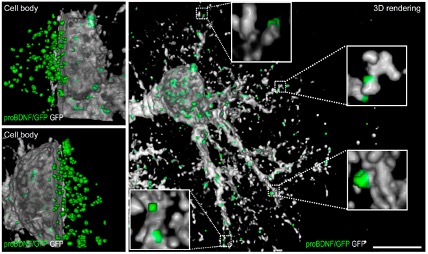The role of glial microdomains in memory consolidation
Long-term potentiation (LTP) of synaptic transmission requires molecular mechanism that converts short neuronal stimulation into persistent biochemical signaling (molecular memory) to maintain changes in the synaptic structure and function.
In the present study we moved away from neurons and described for the first time that glial microdomains are synaptic compartments confining a “molecular memory”. We probed the mechanism underlying the conversion from proBDNF precursor, initially internalized in peri-synaptic glia, to pro-domain (BDNFpro) and mature BDNF (mBDNF) active products for synaptic re-use. Cooperating BDNFpro and mBDNF reinforce TrkB signaling via adaptive molecular mechanisms that facilitate LTP maintenance. We propose a concept of a switching mechanism from one inactive state to multi-functional one: “molecular functionalization”. This specify a strengthening mechanism for a persistent post-synaptic signaling, as it is required for a “molecular memory” to maintain LTP and consolidate memory..
Collaborators: Dr. Marco Canossa (University of Trento)
Dr. Beatrice Vignoli (University of Trento)

3D-SIM images depict an astrocyte transduced with GFP in TBS (10 min) slice from control mice. The insets show 6x magnification of glial endfeet expressing proBDNF/GFP co-localization. The co-localization signal in the half-left (upper) or half-right (lower) part of the cell body is shown in 2x magnification images. The scale bar represents 10 μm.
